CMS-Flow:Features
Hot Start
The term Hot start refers to starting a simulation with an initial condition other zero (cold start). Hot starts are used for specifying initial conditions or restarting simulations at intermediate times. The hot start controls are set in the Flow tab of the CMS-Flow Model Control window.
Hot Start File
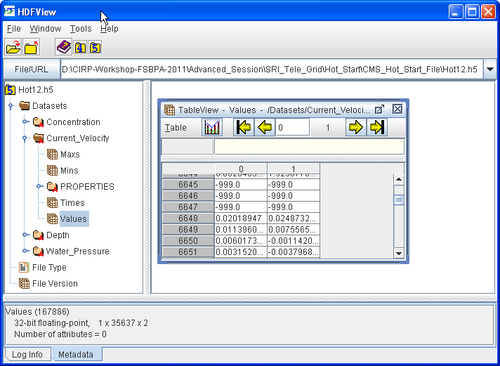
The CMS hot start feature CMS lets the user restart simulations that have been stopped due to electric outages, hardware malfunctions, or model crashes. In the case of a model crash the user, may restart the model using larger solver iterations and/or time steps to stabilize the simulation. The user has the option to specify a hot start output time or an interval for outputting a recurring hot start file. Every time the hot start file is written, it overwrites the previous information. The CMS Hot Start file saves information on the water elevation (pressure), and current velocities. If the sediment transport is active, then the water depth, and sediment concentrations are also saved for each size class. The CMS hot start file is a binary XMDF file, has the name Hot_Start.h5 and is saved in the directory of the CMS-Flow files. Figure 1 shows the structure of the hot start file. After saving a CMS Hot Start file, it is a good idea to rename the file with a different name before using it as an initial conditions file. This way, the file will not be overwritten in future simulations.
Table 1. Hot Start CMS-Flow Cards
| Card | Arguments | Default | Range | Description |
|---|---|---|---|---|
| HOT_START_OUTPUT_FILE | CHARACTER | none | none | Julian hour. |
| HOT_START_TIME | REAL | none | none | Sets the hot start output time. |
| AUTO_HOT_START_INTERVAL | REAL | none | none | Sets the recurring hot start output time. |
Initial Conditions File

There are several situations where it is convenient to specify a user defined hot start file. For example, if the user forgets to setup the model output a hot start file or when running steady state conditions. A hot start file can easily be created and exported by the user from the SMS interface. The model requires at water levels, current velocities, concentrations, and water depths. Any datasets that are missing from the initial file. It is important to note that the names and paths of the initial condition datasets is important.
Table 2. Path and name for initial condition file variables.
| Variable | Path and Name |
|---|---|
| Water surface elevation | Datasets\Water_Elevation |
| Current velocity | Datasets\Current_Velocity |
| Sediment concentrations | Datasets\Concentration |
| Salinity concentrations | Datasets\Salinity |
The steps for creating a user defined hot start or initial condition file from a CMS-Flow solution file are outlined below.
- Import CMS-Flow grid and solution file.
- Sample a time step of the solution datasets for use in the initial condition
- Click on Data | Data Calculator
- Under the Tools section, select Sample time steps.
- Under the Datasets section, click on the Water Elevation
- Click on Data | Data Calculator
- Export the initial condition datasets to an XMDF file
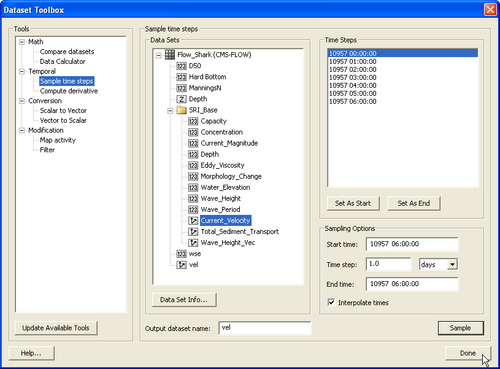
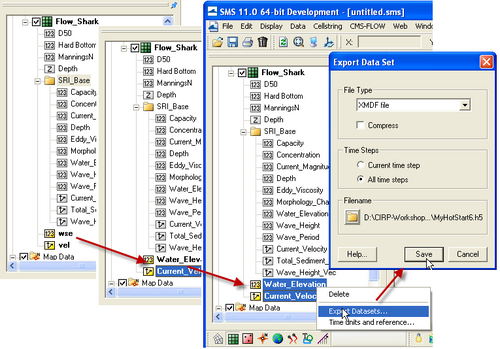
Table 3. CMS-Flow card for specifying the initial condition file.
| Card | Arguments | Default | Range | Description |
|---|---|---|---|---|
| INITIAL_STARTUP_FILE | CHARACTER | none | none | Julian data in YYDDD with YY being last two digits of the year, and DDD the Julian day of the year. |
Global Output

Global output refers to the variables that are output on every active cell on the grid. The global output options are specified in Output tab of the CMS-Flow Model Control window. More information on the global output variables, groups and CMS-Flow cards is provided in the sections below.
Output Datasets
A description of the CMS-Flow cards used to specify the global output variable datasets is provided below.
Table 1. Advanced output datasets.
| Output Dataset | Group | Description | Units |
|---|---|---|---|
| Current_Velocity | Velocity | Depth-averaged and cell-centered current velocity vector dataset and with respect to local grid coordinates | m/s |
| Current_Magnitude | Velocity | Depth-averaged and cell-centered current velocity magnitude dataset | m/s |
| Water_Elevation | Water surface elevaation | Cell-centered water surface elevation | m |
| Eddy_Viscosity | Eddy viscosity | Cell-centered horizontal eddy viscosity | m^2/s |
| Concentration | Transport | epth-averaged and cell-centered sediment concentration | kg/m^3 |
| Capacity | Transport | Depth-averaged and cell-centered sediment concentration capacity | kg/m^3 |
| Total_Sediment_Transport | Transport | Depth-averaged and cell-centered total-load sediment transport | m^2/s |
| Salinity | Transport | Depth-averaged and cell-centered sediment concentration capacity | kg/m^3 |
| Depth | Morphology | Cell-centered still water depth | m |
| Morphology_Change | Morphology | Cell-centered morphology (bed) change. Positive is accretion and negative is erosion | m |
| Wave_Height | Waves | Cell-centered significant wave height | m |
| Wave_Height_Vec | Waves | Cell-centered significant wave height vector | m |
| Wave_Period | Waves | Cell-centered peak wave period | s |
Table 2. Output datasets and groups
| Card | Arguments | Default value | Description |
|---|---|---|---|
| WSE_OUT_TIMES_LIST | INTEGER | 0 | Output time series id for the water surface elevation in m. |
| VEL_OUT_TIMES_LIST | INTEGER | 0 | Output time series id for currentvelocity and magnitude in m/s. |
| MORPH_OUT_TIMES_LIST | INTEGER | 0 | Output time series id for the water depth and morphology (bed) change in m. |
| TRANS_OUT_TIMES_LIST | INTEGER | 0 | Output time series id for sediment transport rates, concentations, and salinity. |
| WAVES_OUT_TIMES_LIST | INTEGER | 0 | Output time series id for the wave height in m, period in sec, and wave vectors. |
| EDDY_VISCOSITY_OUT_TIMES_LIST | INTEGER | 0 | Output time series id for the eddy viscosity in m^2/s. |
| VISC_OUT_TIMES_LIST | INTEGER | 0 | Output time series id for the eddy viscosity in m^2/s. |
| WIND_OUT_TIMES_LIST | INTEGER | 0 | Output time series id for wind velocity and magnitude in m/s. |
| STRESS_OUT_TIMES_LIST | INTEGER | 0 | Output time series id for mean bed shear stress in Pa. |
| WAVE_OUTPUT_DETAILS | ON | OFF | OFF | Outputs additional wave variables including wave direction, radiation stresses, breaking dissipation and roller energy. |
Output Time Series and Lists
The times at which each group is output is determined by the selecting one of four user defined output time series or lists. In SMS versions 10.1 and earlier, the output time series were used. However, because the output time series can become very large for long-term simulations, the time series have been replaced by lists in which the output times are specifying a list of starting, ending and increments. This option is more compact and also makes it easier to manually change the output options in the cmcards file.
Table 3. Advanced output datasets.
| Card | Aguments/Format | Default value | Description |
|---|---|---|---|
| TIME_SERIES_1 | [length of list 1] [output times for list 1] | 0 | Output time series for list 1 in hours. |
| TIME_SERIES_2 | [length of list 2] [output times for list 2] | 0 | Output time series for list 2 in hours. |
| TIME_SERIES_3 | [length of list 3] [output times for list 3] | 0 | Output time series for list 3 in hours. |
| TIME_SERIES_4 | [length of list 4] [output times for list 4] | 0 | Output time series for list 4 in hours. |
| TIME_LIST_1 | [number of sublists] [sublist 1: start, end, increment] [sublist 2: start, end, increment]... | 0 | Sublist(s) for output time series 1. For each sublist, the arguments are starting time, end time and increment in hours. |
| TIME_LIST_2 | [number of sublist] [sublist 1: start, end, increment] [sublist 2: start, end, increment]... | 0 | Sublist(s) for output time series 2. For each sublist, the arguments are starting time, end time and increment in hours. |
| TIME_LIST_3 | [number of sublist] [sublist 1: start, end, increment] [sublist 2: start, end, increment]... | 0 | Sublist(s) for output time series 3. For each sublist, the arguments are starting time, end time and increment in hours. |
| TIME_LIST_4 | [number of sublist] [sublist 1: start, end, increment] [sublist 2: start, end, increment]... | 0 | Sublist(s) for output time series 4. For each sublist, the arguments are starting time, end time and increment in hours.. |
XMDF Output
The default option in CMS is to output all output groups to the same XMDF file (*_sol.h5). This option works well as long as the solution does not get too big. If the solution becomes too big, the SMS interface may have trouble reading the file. The option is also avaible to output different variable groups into separate XMDF files which helps reduce the file and makes it easier to visualize individual datasets in SMS. This feature is available in CMS-Flow Versions 4, Release 5 and more recent. This is done by either manually modifying the cards in the Output section of the cmcards file or by using new Advanced Cards. A list of the cards and their description is provided in the table below.
Table 2. XMDF file .
| Card | Argument Type | Format | Example | Default | Version |
|---|---|---|---|---|---|
| WSE_OUT_FILE | CHARACTER | [<file path>/<file name>] | "<simulation label>_wse.h5" | "<simulation label>_sol.h5" | V4R5 |
| VEL_OUT_FILE | CHARACTER | [<file path>/<file name>] | "<simulation label>_vel.h5" | "<simulation label>_sol.h5" | V4R5 |
| VISC_OUT_FILE | CHARACTER | [<file path>/<file name>] | "<simulation label>_visc.h5" | "<simulation label>_sol.h5" | V4R5 |
| TRANS_OUT_FILE | CHARACTER | [<file path>/<file name>] | "<simulation label>_trans.h5" | "<simulation label>_sol.h5" | V4R5 |
| MORPH_OUT_FILE | CHARACTER | [<file path>/<file name>] | "<simulation label>_morph.h5" | "<simulation label>_sol.h5" | V4R5 |
| WAVES_OUT_FILE | CHARACTER | [<file path>/<file name>] | "<simulation label>_wave.h5" | "<simulation label>_sol.h5" | V4R5 |
| GLOBAL_WATER_LEVEL_OUTPUT | CHARACTER CHARACTER | [<file path>/<file name>] [<dataset path>] | "<simulation label>_wse.h5" | "<simulation label>_sol.h5" | V4R5 |
| GLOBAL_VELOCITY_OUTPUT | CHARACTER CHARACTER | [<file path>/<file name>] [<dataset path>] | "<simulation label>_vel.h5" | "<simulation label>_sol.h5" | V4R5 |
| GLOBAL_MORPHOLOGY_OUTPUT | CHARACTER CHARACTER | [<file path>/<file name>] [<dataset path>] | "<simulation label>_morph.h5" | "<simulation label>_sol.h5" | V4R5 |
| GLOBAL_TRANS_RATE_OUTPUT | CHARACTER CHARACTER | [<file path>/<file name>] [<dataset path>] | "<simulation label>_trans.h5" | "<simulation label>_sol.h5" | V4R5 |
Notes:
- The dataset path is not used by the CMS-Flow and is therefore not necessary to include.
- In CMS-Flow versions ealier than V4R5, the above output cards are not used and all of the variable groups are output to the same XMDF file (*_sol.h5).
XMDF File Compression
The standard CMS-Flow output is written to an XMDF file with the name <Case Name>_sol.h5. The binary file may be written in compressed format using the card described in the table below.
Table 4. CMS-Flow card for compressing the XMDF output file
| Card | Arguments | Default value | Description |
|---|---|---|---|
| XMDF_COMPRESSION | ON | OFF | OFF | Compresses the h5 file by a factor of about 7 |
ASCII Output
In addition to the XMDF output file, CMS-Flow provides the output two types of ASCII output files:
- Tecplot snap shot (*.dat), and history files (*.his)
- SMS Super ASCII files (*.sup, *.xy, *.dat)
The CMS-Flow cards used for outputting these two types of files are described in the Table below.
Table 3. CMS-Flow cards used to output Tecplot and SMS Super ASCII files.
| Card | Arguments | Description | Default value |
|---|---|---|---|
| GLOBAL_TECPLOT_FILES | ON | OFF | Outputs Tecplot ASCII files | OFF |
| GLOBAL_SUPER_FILES | ON | OFF | Outputs Tecplot ASCII files | OFF |
Output Cells
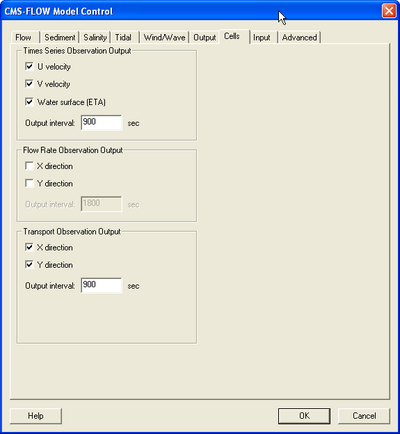
Time series at selected Obervation cells is set in the Cells tab of the CMS-Flow Model Control window. A description of CMS-Flow cards used for specifying Observational cells are described below.
Table 5. CMS-Flow card for compressing the XMDF output file
| Card | Arguments | Description |
|---|---|---|
| TIME_SERIES_INCREMENT | REAL | Sets the output time increment for the Time series Observation points. |
| ELEV_OBS_CELLS_BEGIN | none | Marks the begging of an Times series Observation point list. |
| ELEV_OBS_CELLS_END | none | Marks the end of an Times series Observation point list. |
| FLOW_RATE_INCREMENT | REAL | Sets the output time increment for the Flow rate Observation points. |
| FLOW_OBS_CELLS_BEGIN | none | Marks the end of an Flow rate Observation point list. |
| FLOW_OBS_CELLS_END | none | Marks the end of an Flow rate Observation point list. |
| Q_TRANS_INCREMENT | REAL | Sets the output time increment for the Flow rate Observation points. |
| Q_TRANS_OBS_CELLS_BEGIN | none | Marks the end of an Transport Observation point list. |
| Q_TRANS_OBS_CELLS_BEGIN | none | Marks the end of an Transport Observation point list. |
Statistics
CMS V4.0 has the option to calculate statistics over the whole model domain for a user-specified time period. This option is accessed using the advanced cardss. The starting time, end time, and time interval should be specified in hours with respect to the model start time. The time interval should be larger or equal to the hydrodynamic time step. When activated the global statistics will be output in the same solution file within a subfolder named stats.
This option outputs the statistics for hydrodynamics, sediment and salinity transport. If only the statistics for one group
- Hydrodynamics:
- Maximum current velocity
- Maximum water level
- Residual currents (vectors and magnitude)
- Hydroperiod
- Maximum spatial gradient for water levels
- Maximum spatial gradient for current magnitude
- Sediment Transport and Morphology Change:
- Maximum total load transport rate, m^2/hr
- Net total load sediment transport rates, m^2/hr
- Average total load sediment transport rates, m^2/hr
- Gross total load sediment transport rates, m^2/hr
- Positive and negative total load transport rates (in x and y directions), m^2/hr
- Maximum spatial gradient of bathymetry
- Salinity Statistics:
- Mean Salinity
Table 6. CMS-Flow cards related to output statistics
| Card | Arguments | Description | Default value |
|---|---|---|---|
| GLOBAL_STATISTICS | [t0] [tn] [dt] | Calculates global statistics if specified | none |
| FLOW_STATISTICS | [t0] [tn] [dt] | Calculates flow statistics if specified | none |
| SEDIMENT_STATISTICS | [t0] [tn] [dt] | Calculates sediment statistics if specified | none |
| SALINITY_STATISTICS | [t0] [tn] [dt] | Calculates salinity statistics if specified | none |
Numerical Methods
Solution Scheme
This refers to the temporal discritization of the hydrodynamic, sediment and salinity transport equations. There are two options in CMS: 1. Implicit - First order backward Euler scheme. Uses a time step on the order of 5-15 minutes. Appropriate for cases which can be simulated with large computational time steps such as long term morphology change at inlets. 2. Explicit - First order forward Euler scheme. Uses a time step on the order of 0.5-1.0 second. Appropriate for cases that vary quickly in time such as flooding or barrier island breaching.
| Card | Arguments | Default | Range | Description |
|---|---|---|---|---|
| SOLUTION_SCHEME | CHARACTER | EXPLICIT | EXPLICIT | IMPLICIT | Determines the solution scheme used in CMS-Flow. |
Solver Options
The four different solvers implemented in the implicit solution scheme are the Gauss-Seidel, Gauss-Seidel with Successive-Over-Relaxation, BICGSTAB, and GMRES. The same solver is applied to flow, sediment and salinity. The default solver is the GMRES. The solver may be changed using the advanced card in the table below.
| Card | Arguments | Default | Range | Description |
|---|---|---|---|---|
| MATRIX_SOLVER | CHARACTER | GMRES | GAUSS-SEIDEL | GAUSS-SEIDEL-SOR | BICGSTAB | GMRES | Selects the matrix solver for flow, sediment and salinity. |
| HYDRO_MAX_ITERATIONS | INTEGER | Function of grid size | >0 | Sets the maximum number of iterations for the flow (hydro) solver (outer loop). Typical range: 30-50 for GAUSS-SEIDEL and GAUSS-SEIDEL-SOR, and 20-30 for BICGSTAB and GMRES. |
| PRESSURE_ITERATIONS | INTEGER | Depends on Solver | >0 | Sets the number of solver iterations for the pressure equation (inner loop). Typical range: 80-100 for GAUSS-SEIDEL and GAUSS-SEIDEL-SOR, and 15-25 for BICGSTAB and GMRES. |
| VELOCITY_ITERATIONS | INTEGER | Depends on Solver | >0 | Sets the number of solver iterations for the velocity or momentum equations (inner loop). Typical range: 20-30 for GAUSS-SEIDEL and GAUSS-SEIDEL-SOR, and 5-10 for BICGSTAB and GMRES. |
| SEDIMENT_MAX_ITERATIONS | integer | 20 | >0 | Maximum number of iterations (outer loop) for the sediment transport |
| SALINITY_MAX_ITERATIONS | integer | 20 | >0 | Maximum number of iterations (outer loop) for the salinity transport |
Advection scheme
As in the case of the implicit solution scheme, the same advection scheme is applied for the flow, sediment and salinity transport equations. There are three choices for advection schemes with upwinding in the implicit model: hybrid, exponential and HLPA. The hybrid scheme is fast but is the most diffusive. The exponential scheme is based on the 1D analytical solution to an advection-diffusion equation and produces very stable results. The HLPA is very stable and non-diffusive, but requires slightly more computational time. For most applications, the exponential scheme is recommended and is set as the default. The advection scheme may be change using the advanced card
Table 5. CMS-Flow cards related to numerical methods.
| Card | Arguments | Default | Range | Description |
|---|---|---|---|---|
| ADVECTION_SCHEME | CHARACTER | EXPONENTIAL | NONE | HYBRID | EXPONENTIAL | HLPA | Sets the advection scheme for flow, sediment and salinity. |
Wetting and Drying
Table 5. CMS-Flow cards related to numerical methods.
| DRYING_DEPTH | REAL | Calculated based on solution scheme and courant number | none | Sets to the time step for hydrodynamics in seconds. |
| WATER_PONDING | CHARACTER | OFF | ON | OFF | Turns On or Off water ponding. If water ponding is Off, isolated bodies of water will become dry. |
| ONE_CELL_WIDE_CHANNELS | CHARACTER | ON | ON | OFF | Limits wetting and drying to areas with at least 3 cells wide. When turned off, the model stability is improved. |
Parallelization with OpenMP
Both Intel and AMD processors now are shipping chips with multiple cores/processors (henceforth referred to as "processors") available. CMS-Flow is now configured to make use of these extra processes that are available on newer machines.
Additional information on using Multiple Processors with CMS-Flow can be found here.
Table 5. CMS-Flow cards related to numerical methods.
| Card | Arguments | Default | Range | Description |
|---|---|---|---|---|
| NUM_THREADS | INTEGER | 1 | Determines the number of threads used for parallel processing. | |
| OPENMP_THREADS | INTEGER | 1 | Determines the number of threads used for parallel processing. |
Scripting
Scipting refers to the automation of running multiple CMS runs with different parameters, without manually having to create and edit each alternative. The scripting process can include the following steps:
- Setting up alternatives
- Creating batch file
- Plotting and analyzing results
Scripting can be done using a variety of software programs. The examples shown here were written in Matlab becase it is widely used, easy to read and convenient for plotting and analyzing results.
Setting Up Alternatives
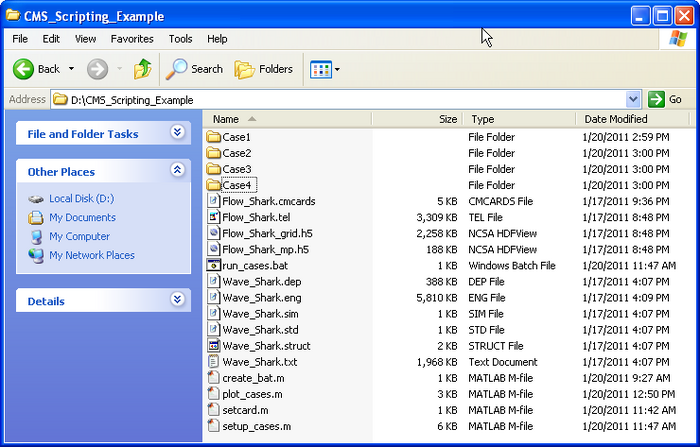
In this example, 4 cases or alterantives are setup using the Matlab script below. The script copies the base setup files into subfolders and then modifies specific CMS-Flow cards in the *.cmcards file. The settings for each case are setup using a structure variable with field names corresponding to each CMS-Flow card (e.g. TIME_SERIES_INCREMENT). Separating each case into its own subfolder keeps the input and output separate and also allows for the different cases to be run at the same time.
% Matlab Script: setup_cases.m
clear all
flow = 'Flow_Shark';
wave = 'Wave_Shark';
ncases = 4; %Number of cases or alternatives
r(1).MANNINGS_N_DATASET = '"Manning_Alt1.h5" "Flow_Shark/Datasets/ManningsN"';
r(1).WAVE_CURRENT_MEAN_STRESS = 'W09';
r(1).TIME_SERIES_INCREMENT = 1800;
r(2).MANNINGS_N_DATASET = '"Manning_Alt1.h5" "Flow_Shark/Datasets/ManningsN"';
r(2).WAVE_CURRENT_MEAN_STRESS = 'DATA2';
r(2).TIME_SERIES_INCREMENT = 900;
r(3).MANNINGS_N_DATASET = '"Manning_Alt2.h5" "Flow_Shark/Datasets/ManningsN"';
r(3).WAVE_CURRENT_MEAN_STRESS = 'W09';
r(3).TIME_SERIES_INCREMENT = 900;
r(4).MANNINGS_N_DATASET = '"Manning_Alt2.h5" "Flow_Shark/Datasets/ManningsN"';
r(4).WAVE_CURRENT_MEAN_STRESS = 'DATA2';
r(4).TIME_SERIES_INCREMENT = 600;
for i=1:ncases
d = ['Case',int2str(i)];
if ~exist(d,'dir')
mkdir(d)
end
copyfile([wave,'.*'],d)
copyfile([flow,'.*'],d)
copyfile([flow,'_mp.h5'],d);
copyfile([flow,'_grid.h5'],d)
cards = fieldnames(r(i));
file = ['.\',d,'\',flow,'.cmcards'];
fork=1:length(cards)
setcard(file,cards{k},r(i).(cards{k}));
end
end
return
The script above requires the subroutine below.
function setcard(cmcardsfile,card,value)
% setcard(file,card,value)
% Overwrites or appends a CMS-Flow card
% in the *.cmcards file
copyfile(cmcardsfile,'temp')
fid=fopen('temp','r');
fid2=fopen(cmcardsfile,'w');
nc=length(card);
ok = false(1);
if ~ischar(value)
value = num2str(value);
end
while 1
tline = fgets(fid);
if ~ischar(tline), break, end
if strncmp(card,tline,nc)
fprintf(fid2,'%s %s %s' ,card,value,tline(end));
ok = true(1);
continue
end
nline = length(tline);
if (~ok && strcmp(tline(1:min(nline,14)),'END_PARAMETERS'))
fprintf(fid2,'%s %s %s',card,value,tline(end));
fprintf(fid2,'%s' ,tline);
break
end
fprintf(fid2,'%s' ,tline);
end
fclose(fid);
fclose(fid2);
delete('temp')
return
Batch File
Although it is possible to launch CMS from Matlab a batch file is preferable to use a batch file because it allows running all of the cases without opening Matlab.
% Matlab Script: create_bat.m cmsexe = 'cms2d_v4b42_x64p.exe'; %CMS-Flow executable batfile = 'run_cases.bat'; %Output batch file fid = fopen(batfile,'w'); for i=1:ncases cmcards = ['.\Case',int2str(i),'\',flow,'.cmcards']; %CMS-Flow cmcards file fprintf(fid,'START %s %s %s',cmsexe,cmcards,char(10)); end fclose(fid); return
The following text shows what the resulting batch file (*.bat) looks like
START cms2d_v4b42_x64p.exe .\Case1\Flow_Shark.cmcards START cms2d_v4b42_x64p.exe .\Case2\Flow_Shark.cmcards START cms2d_v4b42_x64p.exe .\Case3\Flow_Shark.cmcards START cms2d_v4b42_x64p.exe .\Case4\Flow_Shark.cmcards
To run the batch file, simply double click on the file and each case will launch separately in its own MS-DOS window.
Plotting
The following example reads the Observation Point time series output file (*_eta.txt) and plots the 3rd
% Matlab Script: plot_cases.m
close all
eta = cell(ncases,1);
for i=1:ncases
etafile = ['.\Case' ,int2str(i),'\',flow,'_eta.txt' ]; %Water elevation
eta{i} = load(etafile);
end
figure
hold on
for i=1:ncases
h = plot(eta{i}(:,1),eta{i}(:,3),'-'); %3 is the index is the observation point index
end
ylabel('Water elevation, m')
xlabel('Elapsed Time, hr')
return
Units of Measurement
| Variable | Units | Symbol |
|---|---|---|
| Water Surface Elevation | meters | |
| Current Velocity | meters per second | |
| Flow Rate | cubic meters per second | |
| Salinity Concentration | parts per thousand | |
| Sediment Concentration | kilogram per meter cubed | |
| Sediment Transport | meter squared per second | |
| Bed Shear Stress | kilogram per meter per second squared |